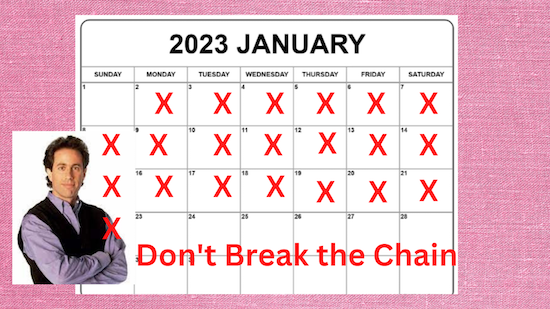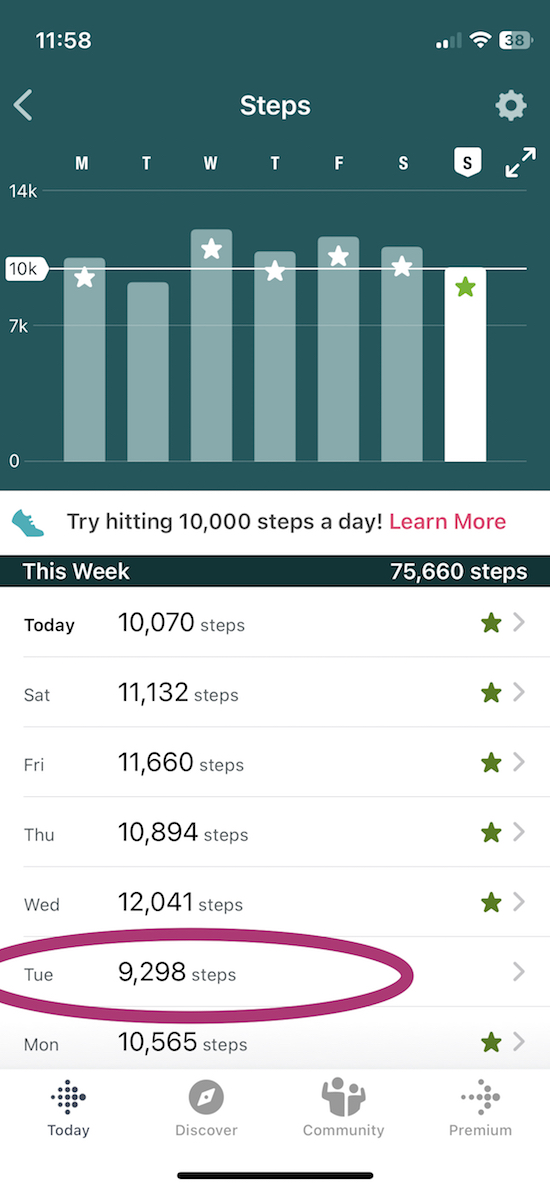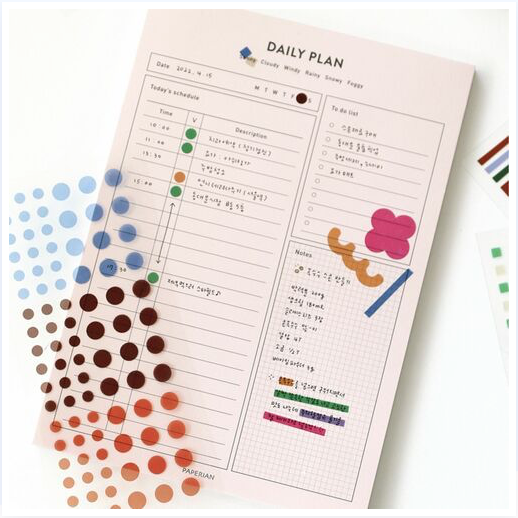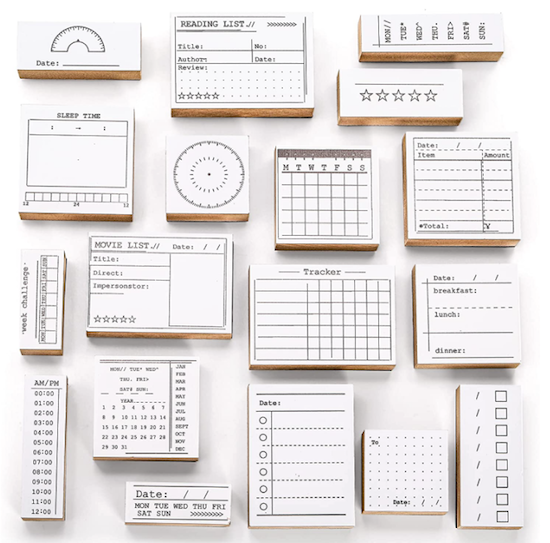Paper Doll Helps You Find Your Ideal Analog Habit Tracker
![]()
If you cannot measure it, you cannot improve it.
~ Lord Kelvin (William Thomson, 1st Baron Kelvin)
If you cannot measure it, you cannot improve it. ~ Lord Kelvin (William Thomson, 1st Baron Kelvin) Share on XTHE BENEFITS OF HABIT TRACKING
Over the past two weeks, in Organize Your Annual Review and Mindset Blueprint for 2023 and Paper Doll’s 23 Ideas for a More Organized & Productive 2023, we touched on the importance of building good habits, either in and of themselves or to replace deleterious ones. We talked about the wisdom of James Clear, author of Atomic Habits: An Easy & Proven Way to Build Good Habits & Break Bad Ones.
Clear’s best-seller, which should be read in its entirety, talks about how successfully tiny habits (at the metaphorically microscopic, atomic, level) are based in four laws of habit creation:
- Make it obvious
- Make it attractive
- Make it easy
- Make it satisfying
In chapter 16 of the book, Clear references the essential nature of habit tracking, and ties habit tracking to the above four laws, but I’d like to speak directly to the last one. He states, “One of the most satisfying feelings is the feeling of making progress.” Well, duh!
And how can we verify our progress? Well, often, we can measure it by looking at the end result. If we’re trying to lose weight, we can measure our progress in having to tighten our belts or buy smaller clothes. If your kids are making progress toward doing better in school, improved grades will eventually make it obvious.
But it takes time to see that kind of progress, and if we’re going to keep motivated, to stick with our habits, we’re going to need to be satisfied daily. We need to see a sign of progress, no matter how minuscule, often. That’s where habit tracking comes in.
Habit tracking gives us an immediate sense of progress, even if the progress is only in our willingness to make an effort.
Persistence is the measurement of your belief in yourself. ~ Brian Tracy
Persistence is the measurement of your belief in yourself. ~ Brian Tracy Share on XTHE DRAWBACKS OF HABIT TRACKING
I should note that there are some inherent drawbacks to tracking our habits.
Our intention is to draw our attention to what we’re doing so that we can strengthen our resolve and recognize our struggles so that we may overcome them.
However, it’s easy to become so focused on our string of achievements that we become obsessed. When that happens, any time we do end the streak has the potential to demoralize us and weaken our resolve to get back on the horse.
If you tell yourself that you will run every day, but the weather is so stormy that “it’s not fit outside for man nor beast,” you may see your options as two-fold and rigid: risk life and limb and frostbite to hit your goal and mark that X or dot on your tracker, or leave it blank. That’s black and white thinking.
And if you leave it blank, you may feel like you’ve already lost. Somewhere, in the back of your head, despondency sets in, and failure to achieve your goal on one day can make you feel like a failure overeall, uninspired to get back to your habit the next day.
But this is an unnecessary dichotomy. Our habit goals are just that, goals. Doing something is always better than doing nothing.
If you can’t run three miles today, could you sprint up and down the stairs in your house, or work out along with a walking or dancing video?
If you miss your 10,000 steps and only manage 7500, could you do 500 extra steps for the next 5 days (or 250 for the next 10, or …)?
Maybe you promised yourself you’d practice the piano for 30 minutes a day, but your work and childcare schedule made that impossible; could you just play some scales to stay limber, or play one song to boost your spirits and remind yourself why this is a goal habit in the first place?
My colleague Karen Sprinkle created a wonderful 48-Week Achievement Guide, an e-book explaining how to use her patented chart for logging progress on goals. She recognized the inherent loss of momentum that comes from not getting to check off a day or week of a habit.
Thus, Karen’s chart creates space for four FREE weeks, weeks in which you have a “get out of jail free” card to not achieve your goals, while not exactly wrecking your streak, either.

Maria White interviewed Karen for episode #13 of her Enuff with the Stuff podcast, entitled Finally Accomplish Goals Using the 48-Week Achievement Guide. Take a listen.
DON’T BREAK THE CHAIN: THE BASIC CONCEPT
One of the best known tales of habit tracking comes from Jerry Seinfeld, master of his own (habit tracking) domain. Once asked how he wrote so many jokes, he explained that early in his career, he made a commitment to himself to write one joke a day.
Just one joke. But one joke every day.
He didn’t tell himself he had to have a Tonight Show monologue. He didn’t push himself to write a sitcom script. He just had to write one joke each day.
Seinfeld had a large wall calendar in his apartment, which showed all the dates in the year. Each time he wrote a joke, he marked the calendar with a red X, and as the story goes, he eventually had a long chain of red X’s to create a visual cue to show how he’d been consistently putting in the effort.
Did he need talent? Of course. Comedic timing? Without question. But Seinfeld’s advice to young comedians was simple: Don’t break the chain!
The chain of red X’s on the calendar is just the simplest form of habit tracking.

AUTOMATED HABIT TRACKERS
The easiest (though not necessarily the best) kind of habit tracker is one that is automatic, or done for you by something or someone else.
I recently bought a new scale, and realized that it had a Bluetooth function. I didn’t really need a scale with Bluetooth, but I was intrigued to find that once I connected it to the iPhone app (which itself connects to the Fitbit app), my scale tells the app not only my weight, but also my BMI, metabolic age, the percentage of my body made up by water and of skeletal muscles, my bone mass and muscle mass, and all the percentages of my fat that is body fat, subcutaneous fat, and visceral fat. And I hope that’s the last time I ever use the word “fat” in this blog!
My point is that all I have to do is to step on the scale (which I do only once per week so as not to obsess) and the app and the magic of Bluetooth does all the rest.
Similarly, while I can (and admittedly do) look at my Fitbit tracker on my wrist, the app takes care of tracking my efforts. Here’s how I did this past week.

Note: while I didn’t make my 10K goal steps on Tuesday last week, I made up for it the next day. I didn’t get down on myself for it, because I knew that progress, not perfection, is key to building habits.
There are even “smart” water bottles that measure and communicate (again, by Bluetooth) with an app to track how much you’ve hydrated!

 However, if you want a journal that you could place on display to clock your habit tracking as the day goes by, there are a variety of styles, from gridded notebooks to artistic visions.
However, if you want a journal that you could place on display to clock your habit tracking as the day goes by, there are a variety of styles, from gridded notebooks to artistic visions.





Wow, so many options!
I think for someone like me, an analog tracker works best. I really enjoy the process of logging my activity. Checking off boxes and adding dots is my idea of fun.
However, for those who don’t enjoy “disciplin-y” kinds of tasks, I think the automatic ones agreat.
That spiral one is downright sexy – especially with all the colors. Makes me want to start a new habit just to put it out on display!
So many, and yet I was just scratching the surface in trying to point out the different categories.
And yes, that spiral version has become the most popular style in recent years. it definitely requires good fine motor coordination to get the smallest cells filled in, but it makes me want to invest in a new set of brush-style markers. Usually, I avoid anything fiddly, but the spiral versions are very cool, and anything cool but fool-proof is motivating!
I currently use an app for habit tracking, but I use it more like a printed journal.
Oooh, I’d love to hear more. Which app, and does it give you a report? How is it more like a journal?
Thanks for reading!
It’s called Grid Diary and you can set up your own grid templates with whatever fields or questions you want. I set mine up with a box foe each area of my life and every day I record anything I did that gave me pleasure or satisfaction.
Oooh, I will definitely check out Grid Diary. It sounds intriguing.
There aren’t reports, but you can display and filter information, so if I want to see (for example) when I practiced music, I can.
Julie:
I went into an internet deep dive a couple years back trying to find various habit trackers and what I found didn’t come remotely close to what you have here. My hats off to you for this amazing blogpost!
Hi, Joeseph! Thanks for reading the post, and I really appreciate your kind words. I tend to write incredibly long posts with the hope that people will enjoy this kind of deep dive. Thank you again for making me feel like the effort was worth it. You made my day!
As Seana said, sooo many options! I am working on consistently achieving 10,000 steps a day. I know I walk many more than 10,000 steps but I do not have a smart watch and I don’t always have a pocket in which to stash my phone. I’m thinking about the oura ring.. to help me track steps and more.
I love the idea of the water bottle which helps track how much water you drink and the scale which syncs to your other devices.
Checking off boxes doesn’t appeal to me however, I keep a running list in a notebook and scratch off the things I’m working on as I complete them. If I don’t get something done, I move it to the next page in the notebook to help me remember.
An Oura ring seems like a nifty (if much pricier) option. I like that my current (sub-$100) Fitbit is a slimline option, as I am not comfortable wearing a bulky watch like an Apple Watch. When I originally got it, I’d also separately the “skins” they make to wear the Fitbit clipped to the waist or bosom as I’d done with my previous Fitbit. I find it’s useful for times when I am going to a more formal event and don’t want to miss out on counting the day’s steps (or dance steps!).
I understand what you’re saying about checking off boxes, and your approach makes sense for tasks and events, though a running list may not make sense for habits one wants to stick to that feel/seem far removed from a work list, like “getting to bed by X o’clock” or “eating three vegetables/day.” I suspect most of us will want a combination of different methods for tracking habits.
I am grooving on all of the analog options you shared, Julie! The makeslife sticky note tracker is very cool- simple, easy entry, and flexible. And who knew they made “smart” water bottles? Amazing! I know about the “smart” scale because we purchased one recently. My husband and I like to joke about it. The scale consistently shows our weight, but it’s temperamental with showing the other metrics. It’s humorous, really. It’s supposed to help you track things automatically, but there are days when it doesn’t feel like it. Sound familiar?
While analog tracking is enticing, for me, my habit tracking is done digitally. I use a variety of tracking methods for the different areas of focus. One of the most effective tools is my 2Do app. I set a daily repeat for the habit I want to pursue, like walking or meditating daily. When I do it and check it off, it automatically sets a new cue for the next day. And even though I’m not physically drawing a “red x” or coloring in a box, when I mark the electronic box, the app draws an animated line through the item, gets marked “done,” and disappears from my list. It’s satisfying, and I get that slight endorphin ping too.
The bottomline is use what works- analog, digital, or an accountability partner. Developing new habits takes work and commitment. So whatever methods support change, go for those.
Thank you for the enlightening post.
I completely get what you’re saying, Linda. The biggest annoyance with my scale is that the app requires my phone to be nearby for the Bluetooth to work. I generally don’t have my phone in the bathroom, which is where I weigh myself, meaning I have to remember to bring the phone to the general vicinity of the scale to ensure they communicate. However, I don’t want my phone in the bathroom, where there’s water and a non-carpeted floor, so then I have to take it out of the bathroom again before I can shower. It’s not perfect, but I do like the idea of knowing how much my bones weigh. 😉
Thanks for reading, and you’re right — whatever helps us keep our commitments to ourselves is the best option!
You’ve really found an option for each type of style people may have. Thanks as always for such great research and recommendations.
Thank you for your kind words, Janet, and for reading Paper Doll!
First of all, your posts are always meaty and chock-full of goodies. Thanks for covering all the bases, Julie.?
And, second, it’s fantastic that there are so many options to track (and build) solid habits. There’s a flavor for just about anyone. Mine, of course, is digital. “Look, Ma! No math skills required!” LOL ?
LOL, Deb, I’d expect no less from my digital-everything friend! Thank you for your kind praise!